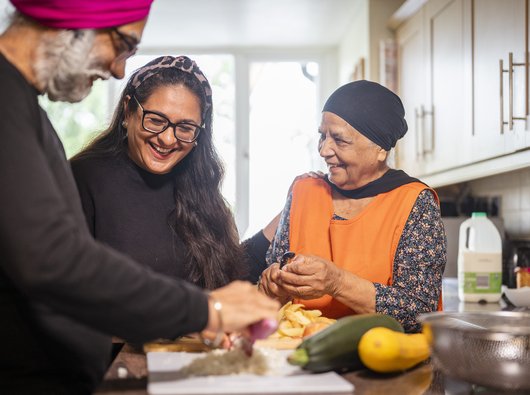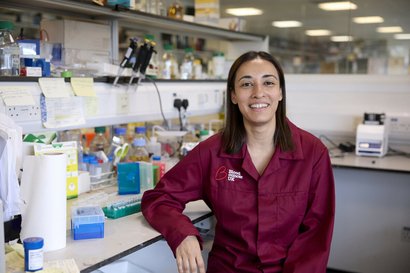Treatment for chronic myelomonocytic leukaemia (CMML)
Treatment can help manage the symptoms of CMML so you can concentrate on living your life.
Treatment aims
For most people, CMML can’t be cured, but it can be treated.
This means that treatment can help you live longer than you would without treatment. It also helps with the symptoms of CMML and how it affects your daily life. Many people can live a relatively normal life with CMML.
There is no standard treatment path for people with CMML. Doctors use a range of factors to decide the best treatment for you, including your general health and fitness, the type of CMML you have, your test results and your risk level.
It might take some time to understand your condition and getting diagnosed can feel overwhelming. Take your time to process the information, and when you are ready, your hospital team will be there to support you with any questions you might have.
You can also call our Support Service on 0808 2080 888 at any time and leave a message – we will call you back. Or fill in this web form for support by email.
Active monitoring
Some people who are diagnosed with CMML may not need treatment straight away.
If you have no symptoms, or a few symptoms you can manage well, your doctor may recommend an approach called active monitoring (also known as watch and wait).
For many slow growing (chronic) types of blood cancer like CMML, there is no evidence to suggest that having treatment earlier helps in the long term. Treatment can cause side effects and other problems, so it is best to wait until it’s needed.
Active monitoring means having regular tests to check if or how the CMML is progressing. If you do start to show symptoms, your doctors may decide to start you on treatment such as chemotherapy. People with CMML are likely to have treatment at some point.
While you are on active monitoring, doctors may give you advice on keeping well. This might include ways you can reduce your risk of infection and keep active and strong.
It can be challenging coming to terms with the uncertainty and emotional impact of active monitoring. Many people find it helpful to connect with others in a similar position. You can do this through our online community forum, where you can find conversations and advice about being on active monitoring (watch and wait).
We have more guidance on how you can cope physically and emotionally during CMML, including when you are on active monitoring.
Blood cancer stories
Read about other people's experience of blood cancer, including active monitoring, treatment, and every aspect of living with blood cancer.
Hear from others with a blood cancer diagnosis.

Chemotherapy
When you need treatment, you are likely to be offered chemotherapy. Chemotherapy uses cytotoxic (cancer killing) drugs to stop the CMML cells multiplying.
There are different kinds of chemotherapy, and your team will decide on the best type for you based on the type of CMML you have, your risk level and your general health and fitness.
Hydroxycarbamide
Hydroxycarbamide works by interfering with the DNA in cancer cells. Damaging the DNA stops cancer cells maturing so they don’t survive for long.
You normally take hydroxycarbamide as a capsule at home. How long you take it for depends on how you respond to it and whether it improves your blood counts. Lots of people stay on hydroxycarbamide for a long time, but your doctors will recommend what’s best for you.
Research has found that hydroxycarbamide works best for people who have a high white blood cell count that needs to be controlled. This means it is mainly used for people who have the proliferative type of CMML – MP-CMML.
If you have MP-CMML, hydroxycarbamide can lower your white blood cell counts, reduce your spleen if it’s swollen and manage other symptoms effectively.
Azacitidine
Azacitidine is a type of chemotherapy called a hypomethylating agent. It works by disrupting an enzyme that makes proteins which CMML cells need grow. Enzymes are natural substances in our bodies that speed up chemical reactions.
Azacitidine is normally given as an injection under the skin (a subcutaneous injection) in hospital. A treatment cycle is usually one injection every day for a week, followed by three weeks of no treatment. The number of cycles you need will depend on lots of things, including how well the treatment works in the beginning.
Your team will talk you through what to expect from treatment with azacitidine and how long it’s likely to take. They will also answer any questions you have.
Azacitidine is usually only recommended for people who have the dysplastic type of CMML – MD-CMML.
Low dose cytarabine
Cytarabine is a chemotherapy drug that works by blocking the growth of cancer cells. It is used in high doses for some blood cancers such as MDS and MPNs, but research has shown that for some people with CMML, high doses are not effective and cause severe side effects.
For a few people with CMML, a low dose of cytarabine can control the CMML for a while, with fewer side effects. It is usually recommended for people with CMML if hydroxycarbamide isn’t suitable.
Low dose cytarabine is given as an injection under the skin (a subcutaneous injection), twice a day for 10 days. You might stay in the hospital for this period, or you might have a community nurse come to your house. It may be possible for you or someone in your family to be trained to give the injection, so that you can have treatment at home.
Stem cell transplant
Having a stem cell transplant is currently the only potential cure for CMML. This involves receiving stem cells from a matched donor and is known as an allogeneic or donor stem cell transplant.
The donor may be a relative such as a sibling. Or you may be matched with someone who is not related to you but who has volunteered to donate stem cells and is on a national or international stem cell register.
Stem cell transplants are an intensive treatment and can have complications. They are not suitable for everyone, and your doctor will take into account your age, your overall health your risk level and other treatments before they recommend it.
If a stem cell transplant is a good option for you, you will have chemotherapy or radiotherapy to get rid of as many CMML cells as possible before for the transplant. You are likely to stay in hospital for several weeks.
A stem cell transplant brings the chance of a cure, but for some people, the CMML will come back (relapse).
You can read more about stem cell transplants in our free booklet, Blood stem cell and bone marrow transplants: The seven steps.

If someone you know has blood cancer
If you're close to someone who's been diagnosed with blood cancer, you may find it helpful to read our information for family, friends and carers.
Side effects of chemotherapy
Chemotherapy aims to destroy the abnormal cells within your body, but it also affects healthy cells. This can make your blood counts very low – doctors sometimes call this myelosuppression – which can cause some side effects.
Side effects vary from person to person, depending on the drug and the dose you take, and any other medical conditions you might have. Some of the most common side effects that can come with drugs used to treat CMML include:
- a higher risk of infections because of low white blood cells
- feeling breathless and, depending on your skin colour, looking pale or greyish because of low red blood cells (anaemia)
- bruising and bleeding easily because of low platelets
- headaches or dizziness
- feeling or being sick
- loss of appetite or weight loss
- sore mouth, nose, or throat
- bowel problems, including diarrhoea (frequent watery poos) or constipation (difficulty pooing)
- pain in your stomach area
- feeling extremely tired (fatigue)
- pain in your joint or muscles
- difficulty weeing
- pain where the needle goes in if you are having injections.
We have more information about common side effects of blood cancer treatment, including things your hospital team can do to help, and things you can do too.
Treatments for cancer can also have longer-term side effects such as nerve damage, bone and joint pain, and changes to how the thyroid gland works.
Fertility problems
Some types of treatment can also affect your ability to have a child (your fertility). If this is something that affects you, talk to your hospital team about ways to preserve your fertility before you start chemotherapy.
We have more information about blood cancer treatment and fertility.
Supporting you with side effects
Your team will talk you through possible short-term and long-term side effects that might be caused by your treatment. You won’t experience all the possible effects, but some can be unpleasant and affect your daily life.
There are some things you and your hospital team can do to help manage the side effects of treatment. For instance:
- Your team might prescribe medicine to help your body make more healthy blood cells. This will boost your immune system and help you fight off infections.
- You may have anti-emetic (anti-sickness) medication, which can stop you feeling or being sick (nausea and vomiting).
- Your team may suggest changes to your diet and lifestyle which can lower the risk of infection and neutropenia (low white blood cells called neutrophils), as well as improving other symptoms like nausea, fatigue, and feeling generally unwell.
- Lots of people find that mindfulness and relaxation techniques can improve their sense of wellbeing as well as help them cope with physical symptoms. Ask your team for guidance about what might be best for you and whether there are any support groups you could join. Or contact us on 0808 2080 888 or via this web form.
Supportive care
Most people with CMML are likely to have supportive care while they are having treatment. Supportive care is treatment that does do not actively target the cancer but aims to ease the symptoms and side effects, improving your quality of life.
Supportive care can be adjusted depending on your blood counts.
Growth factors
Growth factors are a type of medicine that helps the bone marrow to develop new healthy blood cells.
If you have low red blood cells and have symptoms of anaemia (breathlessness, tiredness) you may be given a growth factor called erythropoietin or EPO. This helps new red blood cells to grow.
Another growth factor is granulocyte colony-stimulating factor (GCSF), which helps you produce more white blood cells. You may need this if your white blood cells are too low, especially if you are having chemotherapy.
Growth factors are given as an injection under the skin.
Blood or platelet transfusions
You may need a blood transfusion. This is when you are given blood from a donor through a needle into your vein.
Blood transfusions help to increase the number of red blood cells in your blood. Some people may also need a platelet transfusion. Platelets are blood cells that make your blood clot to stop bleeding or bruising. Some people may have regular transfusions of red blood cells, platelets or both.
Read more about what a blood transfusion is and what happens.
If you have a lot of blood transfusions over a long period of time, you might need medicine to prevent iron building up in your body and damaging some of your organs. It normally takes a very long time for this to happen, and you may not need this treatment.
Antibiotics
Having low blood counts can make you more likely to get infections which last longer and are more serious than usual. So people with CMML and other blood cancers often take antibiotics to prevent or treat infections.
Remission from CMML
If there are few or no abnormal cells left after your treatment, you may be told you are in remission.
Doctors will check that your test results have improved since your treatment. In particular, they will check that the number of blast cells in your bone marrow is less than 5% (one twentieth). This is called a complete remission.
Not everyone with CMML will have a complete remission. But even if you don’t, treatment can still work well enough to help with the symptoms and give you a good quality of life. So a different level of remission may still be a good result.
People can stay in remission from CMML for many years. You will have regular check-ups, similar to being on active monitoring. These will include blood tests to see:
- how well you are recovering from treatment
- if you have any long-term side effects
- if you are showing any symptoms of the CMML coming back.
You do not have to wait for a check-up if you are worried about anything. Just contact your doctor or nurse for advice.
You might stay on treatments like azacitidine or hydroxycarbamide for as long as they keep working and you feel well. The aim is to keep you in remission for as long as possible. Stopping the treatment might mean the CMML comes back more quickly.
Relapse
Sometimes treatment may work well, but after a while the CMML comes back or gets worse. This is known as relapse.
Depending on your blood counts and how long it has been since your last treatment for CMML, your hospital team may decide to try the same treatment again. Or they may recommend a different treatment. This might be another chemotherapy drug or a stem cell transplant.
For some people, the first treatment does not work as well as hoped for. If this happens, your doctor may suggest a suitable clinical trial.
Research and clinical trials
There’s a lot of research being done into CMML, MPN and MDS and other types of blood cancer. Carefully designed clinical trials play an important part in helping us understand blood cancer and how to treat it.
If you have CMML and need treatment, you might have the chance to take part in a clinical trial. Your doctor will explain what this will involve. You can ask your team any questions about the trial. If you are offered a clinical trial, you do not have to take part if you don’t want to. You will still receive the best possible treatment available.
If you want to learn more about clinical trials that may be appropriate for you, or have any questions about trials, get in touch with our Clinical Trials Support Service.

Our research
Our £500 million investment in research since 1960 has helped transform treatments and taken us to the point where beating blood cancer is now in sight. Our researchers are working to finish the job.
More About This